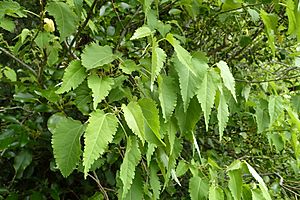Hoheria lyallii facts for kids
Quick facts for kids Hoheria lyallii |
|
|---|---|
 |
|
| H. lyallii in Aoraki Mt Cook Village, Canterbury, New Zealand | |
| Scientific classification | |
| Genus: |
Hoheria
|
| Species: |
lyallii
|
Hoheria lyallii, also known as the mountain lacebark, is a special type of flowering plant. It belongs to the mallow family, which is called Malvaceae. This plant is originally from New Zealand. You can find it growing in the dry, mountainous parts of the South Island, especially in areas like eastern Canterbury and Marlborough.
Contents
Discovering the Mountain Lacebark
The mountain lacebark is a beautiful plant that can grow quite tall, up to about 7 meters (or 23 feet). It can be a deciduous shrub (a bushy plant that loses its leaves in winter) or a small tree. Its leaves are a bit hairy, and in the summer, it blooms with lovely white flowers that have a light, pleasant smell.
Why Is It Called lyallii?
The second part of its scientific name, lyallii, was chosen to honor a Scottish naturalist and explorer named David Lyall. He lived from 1817 to 1895 and explored many places, including New Zealand. Scientists often name new species after the people who helped discover or study them.
Special Recognition
In the United Kingdom, the mountain lacebark has received a special award called the Royal Horticultural Society’s Award of Garden Merit. This award means it's a great plant for gardens because it grows well and looks good.
Māori Connections
The mountain lacebark, along with a similar plant called Hoheria glabrata, is known by the Māori name houi. Long ago, the Māori living on the South Island likely used parts of these plants to make textiles, which are materials like cloth.

